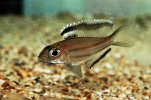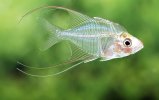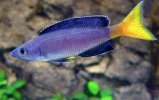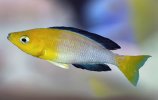This morning I was looking around online to see if any of the fishes on my 'To Do' list might be available, and I came upon one retailer (whose name shall not be mentioned) who exemplifies one of my pet peeves- listing all 'African Cichlids' together. If you're looking for Tanganyikans, this is particularly frustrating because it's like looking for a needle in a haystack amongst reams and reams of Malawians. I did find one Tanganyikan in the mix, however- Neolamprologus multifasciatus, $80 each. 


You are using an out of date browser. It may not display this or other websites correctly.
You should upgrade or use an alternative browser.
You should upgrade or use an alternative browser.
What did you do with your tank(s) today?
- Thread starter DMD123
- Start date
fishguy1978
Legendary Member
That wasn’t for a group? Wild caught or F1? Still that’s outrageous.This morning I was looking around online to see if any of the fishes on my 'To Do' list might be available, and I came upon one retailer (whose name shall not be mentioned) who exemplifies one of my pet peeves- listing all 'African Cichlids' together. If you're looking for Tanganyikans, this is particularly frustrating because it's like looking for a needle in a haystack amongst reams and reams of Malawians. I did find one Tanganyikan in the mix, however- Neolamprologus multifasciatus, $80 each.
$80 for one tank-raised Multi. You see some really crazy things online...That wasn’t for a group? Wild caught or F1? Still that’s outrageous.
fishguy1978
Legendary Member
I’m not charging enough$80 for one tank-raised Multi. You see some really crazy things online...

Thank you my friendThis afternoon I made a brief (like ten minutes) stop over at Maddness’ house to drop off a male gold saum. There is no better hobbyist to raise it up to adulthood. View attachment 12767
Ive been trying to get my Sajica to breed. The dominant male and a female have been very friendly with each other and seem to have a bond starting up. Ive added two clay pots of different sizes and had even tried a cold water water change. Essentially these are like convicts and should be breeding like rabbits but they just wont take the next step... ideas?
fishguy1978
Legendary Member
Interesting looking too. Is this one of the mud tunnellers?A new shipment of WC Tanganyikans just arrived at Rare Fish USA, including one of the seldom-seen species on my 'To Do' list- Trematocara marginatum. Unfortunately, they are $199 each.
No, Trematocara marginatum are open-water fishes, and believe it or not, these delicate-looking little things are carnivores Looks can be deceiving.Interesting looking too. Is this one of the mud tunnellers?
I've always liked fishes with transparent or semi-transparent bodies. Years ago I had a species tank of Gymnochanda flamea, shown below. Delicate in every way, and extremely pretty in natural light, they are one of my all-time favourites.
I was looking for a decimal point there and when I didnt see it... then the impact of the price hit and I was like WOW!Unfortunately, they are $199 each.
A bit boring right now in the fishroom. Nothing really going on, just typical cleanings and feedings.
65B - Been trying to get my sajica to breed but they just are not there yet.
46 bowfront- My planted tank is looking bland since all my tall plants (java ferns) seemed to have babies and all the tall stuff died off. Was thinking of getting a cave for the apisto to see if they would breed.
90g - Noticed a hoplo getting larger pectoral fin spines, which usually means male. So if that holds trueI have a mix of 1 male to 3 female. Would really be cool to see them breed. The whole bubble nest thing sounds interesting.
300g - Pearsei growing but still a small fish considering his future potential size. Missing a bala shark does make the tank feel empty, but not sure if I want to replace it, the other two seem to get along perfectly. Been thinking to add another bichir but thats always a hot mess since that results in aggressive little tiffs and my two get along beautifully.
Thats about it for my fish keeping right now. Anyone doing anything new or different?
65B - Been trying to get my sajica to breed but they just are not there yet.
46 bowfront- My planted tank is looking bland since all my tall plants (java ferns) seemed to have babies and all the tall stuff died off. Was thinking of getting a cave for the apisto to see if they would breed.
90g - Noticed a hoplo getting larger pectoral fin spines, which usually means male. So if that holds trueI have a mix of 1 male to 3 female. Would really be cool to see them breed. The whole bubble nest thing sounds interesting.
300g - Pearsei growing but still a small fish considering his future potential size. Missing a bala shark does make the tank feel empty, but not sure if I want to replace it, the other two seem to get along perfectly. Been thinking to add another bichir but thats always a hot mess since that results in aggressive little tiffs and my two get along beautifully.
Thats about it for my fish keeping right now. Anyone doing anything new or different?
John58Ford
Well-Known Member
That looks like a rather large errand! What's going in there?I went on an errand.
I've been concentrating on expanding my Cyprichromis colonies. I have two medium-sized colonies of Cyprichromis leptosoma Utinta and one small colony of C. leptostoma Mpimbwe, and I would like to raise enough fry from these to populate all my non-Tropheus tanks. Cyps are often viewed as dithers for other Tanganyikans because they are one of the few active, open-water fishes from the lake that are available (even though they are still quite expensive). That's a shame in my view, because these delicate, interesting fishes only show at their best when they are kept in large groups, fed appropriately, and have ample space. A maternal mouthbrooder whose territories are 3-dimensional open spaces without any reference to a substrate? It has to be one of the most interesting spawning behaviours I've ever seen....Anyone doing anything new or different?...
I now have a couple of 45L tanks that serve as combination brooding/rearing tanks. These are shoaling fishes that do poorly in isolation, even for short periods, and I have found that the best way to handle brooding females is to place them in a tank with other similarly-sized females (midwives, of a sort) and/or fry (which they don't bother). Under these conditions all concerned seem to thrive.
A typical Cyprichromis brood is only ~6 fry, so this project is taking a while, but spawning is now occurring regularly in both parental colonies. One would not generally keep two distinct Cyprichromis populations together for fear of hybridization, but Utinta and Mpimbwe can be readily distinguished, even when young, so I will be able to segregate them appropriately before they reach breeding age. Eventually I would like to have 30-40 fishes in each of my 6-foot tanks.
Cyprichromis leptosoma Utinta-
Cyprichromis leptosoma Mpimbwe-
Last edited:
John58Ford
Well-Known Member
I think well over 115 gallons of water, about 100 male Endlers, a few long fin bristlenose, a few dwarf wood cats, a few Cory, a clown pleco, a few Otto, a dozenish rummynose, a dozenish silvertip, a bunch of snails and a mess of plants. It's a very long, shallow errand, I think it will grow plants much better than my nano rack and long term it will stock any soft water fish I desire.That looks like a rather large errand! What's going in there?
fishguy1978
Legendary Member
Moved the female choco back in with the male. She was immediately flirting and trying to please but he still isn’t interested. He’s not vicious mostly just pushing on her.
My hybrid eggs are being closely guarded my mom and dad.
I also have my son working on the tanks today. He is moving my one 8” sailfin from my trimac tank to my Oscar tank for some natural algae relief.
He is also doing a water change on the bedroom fahaka puffer tank as we speak.
Told him to keep his pinky finger out of there or it might get nibbled. Haha
I also have my son working on the tanks today. He is moving my one 8” sailfin from my trimac tank to my Oscar tank for some natural algae relief.
He is also doing a water change on the bedroom fahaka puffer tank as we speak.
Told him to keep his pinky finger out of there or it might get nibbled. Haha
John58Ford
Well-Known Member
I've been way too busy the last couple months with sports and music activities in the community to do much fish work worth documenting. I had an opportunity arise, it was something I didn't ever expect to find in my price range so it was a nice surprise. I have been cautious about "large tanks" as I do know the structure and layout of my floor trusses and foundation vs what I would like are very hard to match up. I need a shallower and wider tank than what you usually see in the 100+ gallon range and happened across one.
6'x18"x21", drilled and plumbed with a ~15 gallon sump, dc return pump, a couple nice lights. Today before leaving (had to drive the kids to the parade) I started cleaning the area out and arranging for a big transfer. All the plants and residents of my soft water tanks are going to make a 2 stage move, first into my 55s, then into the beast after removing the rack and filling/settling the sand in the new one. Lots of my old equipment will be looking for homes, the racks would be great in a garage or breeding system somewhere I'm sure.
6'x18"x21", drilled and plumbed with a ~15 gallon sump, dc return pump, a couple nice lights. Today before leaving (had to drive the kids to the parade) I started cleaning the area out and arranging for a big transfer. All the plants and residents of my soft water tanks are going to make a 2 stage move, first into my 55s, then into the beast after removing the rack and filling/settling the sand in the new one. Lots of my old equipment will be looking for homes, the racks would be great in a garage or breeding system somewhere I'm sure.
John58Ford
Well-Known Member
Pretty much on the outside, this is an acrylic job with a fairly large corner weir slotted down 1.5";so I'm adding up to about 115 in the display, less for sand etc of course. hopefully it's pretty when I'm done. I haven't tried to scale up these plants yet, and the extra 6 bags of sand will surely take a while to season up and support good growth.72" x 18" x 21"? That's a standard 125.
Edited: in other fish news, I'm finally having two of these awesome little wood cats hang out at feeding time with the lights on. The third still hangs out in the log until the lights go out but their fins are looking pretty good.
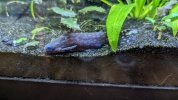
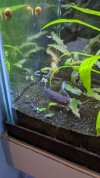
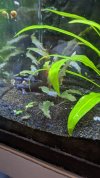
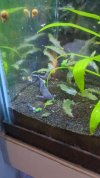
Now I'm going to move tanks and they'll hide for another 3 months lol.
Last edited:
